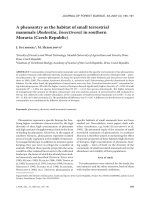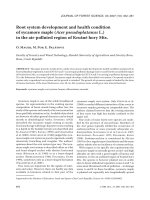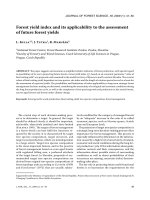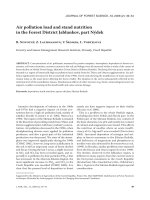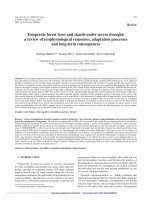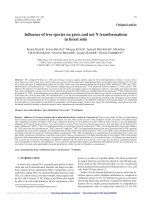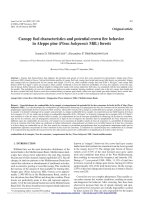Báo cáo lâm nghiệp: "in leaf development and thesis of Prunus serotina seedlings" doc
Bạn đang xem bản rút gọn của tài liệu. Xem và tải ngay bản đầy đủ của tài liệu tại đây (184.93 KB, 3 trang )
Ontogenetic
changes
in
leaf
development
and
photosyn-
thesis
of
Prunus
serotina
seedlings
S.B.
Horsley
1
K.W.
Gottschalk
2
1
Northeastern
Forest
Experiment
Station,
USDA-Forest
Service,
P.O.
Box
928,
Warren,
PA
16365, and
2
P.O.
Box 4360,
Morgantown,
WV
26505,
U.S.A.
Introduction
Black
cherry
(Prunus
serotina
Ehrh.)
is
an
important
commercial
hardwood
species
in
the
northeastern
United
States.
The
species
is
considered
intolerant
of
over-
story
shade,
although
young
seedlings
usually
develop
in
the
shade
of
an
over-
story
or
in
partially
cut
stands.
Leaf
age
and
developmental
stage
are
important
determinants
of
many
physiological
pro-
cesses
in
trees,
especially
those
with
indeterminate
growth.
Net
photosynthetic
rate
is
a
process
that
influences
survival
or
death
of
young
seedlings.
Relationships
between
plant
age,
leaf
age
and
develop-
ment,
and
net
photosynthesis
have
been
investigated
for
only
a
few
hardwood
spe-
cies.
Materials
and
Methods
Black
cherry
plants
were
raised
from
half-sib
seed
and
grown
in
sand
culture
watered
daily
with
a
complete
mineral
nutrient
solution.
The
plants
were
grown
in
growth
chambers
at
25°C
during
16
h
d
under
approximately
335
,umol
M-2-S-1
PPFD
from
cool
white
fluorescent
and
incandescent
larrrps.
Nights
were
8
h
at
18°C.
Humidity
was
not
regulated.
We
removed
the
cotyledons
and
first
4
leaves
when
plants
reached
the
8-10
leaf
stage,
since
these
leaves
often
abscised.
So
the
5th
true
leaf
produced
was
given
the
serial
leaf
number
1.
We
used
the
plastochron
index
of
Erickson
and
Michelini
(1957)
to
measure
age
of
plants,
and
of
leaves
on
plants
in
units
of
developmental
time.
The
index
leaf
length was
set
at
75
mm,
since
small-
er
leaves
were
difficult
to
handle
in
our
leaf
chambers due
to
their
short
petioles.
The
plas-
tochron
index
was
calculated
from
measure-
ments
of
the
smallest
leaf
that
had
a
leaf
lamina
at
least
75
mm
long
and
the
next
serial
num-
bered
leaf
above
it.
Leaf
area
was
measured
on
277
leaves
from
14
plants
ranging
in
plastochron
age
from
18-40.
Each
leaf
was
measured
in
situ
3
times
with
a
Li-Cor
lea.f
area
meter.
The
length
and
width
of
each
leaf
were
measured
to
the
near-
est
mm
with
a
ruler.
The
average
area
from
the
3
measurements
was
used
to
develop
predic-
tive
models
for leaf
area.
Net
photosynthesis
was
measured
in
a
20
cm
water-cooled,
plexi-
glass
leaf
chamber
by
infrared
gas
analysis
in
an
open
system.
The
system
was
operated
with
330
ppm
of
humidified
C0
2
at
a
leaf
tempera-
ture
of
25±0.5°C.
Illumination
was
provided
with
a
single
400
W
sodium
iodide
metal
arc
lamp
at
600
pmol
m-
2
-s-
1
PPFD.
Gas
flow
was
maintained
at
900
ml/min.
Prior
to
insertion
in
the
leaf
chamber,
leaf
area
was
measured
with
a
Li-Cor
leaf
area
meter.
We
measured
plants
ranging
in
age
from
7
to
20
plastochrons.
Vertical
profiles
were
measured
on
3-5
plants
at
each
plant
age
on
all
leaves
75
mm
and
longer,
beginning
with
serial
leaf
number
7.
For
example,
only
leaf
7
was
measured
on
a
plastochron
age
7
plant,
whereas
leaves
7
through
20
were
measured
on
a
plastochron
age
20
plant
(Dickmann,
1971).
).
Results
All
of
the
models
tested
to
predict
leaf
area
from
various
combinations
of
leaf
length
and
width
had
good
correla-
tions
and
significant
regressions.
Several
models
explained
97%
or
more
of
the
variation.
The
simplest
of
these
models
is
the
linear
regression
which
explained
98%
of
the
variation
and
does
a
good
job
of
predicting
leaf
area
from
length
and
width
measurements.
Under
our
growing
conditions,
the
plas-
tochron
interval,
or
length
of
chronological
time
between
the
time
a
leaf
reaches
index
leaf
length
of
75
mm
and
the
time
the
next
serial
numbered
leaf
above
it
reaches
75
mm,
varied
from
1
to
3
d
on
different
plants.
Leaves
with
serial
leaf
numbers
less
than
about
9
were
shorter,
had
less
leaf
area
and
often
had
a
larger
plastochron
interval
than
higher
serial
numbered
leaves.
Leaves
on
older
plants
required
a
greater
number
of
plastochrons
to
reach
full
expansion
than
leaves
on
younger
plants.
Maximum
leaf
size
be-
came
stable
between
serial
leaf
numbers
10
and
13.
Leaves
on
older
plants
also
re-
quired
successively
more
plastochrons
to
reach
maximum
net
photosynthesis.
Leaf
area
increased
with
leaf
plastochron
age
(LPA)
up
to
a
maximum
at
LPA
4-5
and
then
remained
constant.
As
plant
size
increased,
mean
leaf
area
increased
from
47.2
to
57.5
to
62.2
cm
2
for
7,
10
and
13 3
leaf
plants,
respectively.
Since
our
index
leaf
was
comparatively
long,
all
of
the
leaves
we
measured
were
net
producers
of
photosynthetic
products.
Maximum
net
photosynthesis
was
reached
before
leaves
were
fully
expanded.
In
a
horizontal
series,
serial
leaf
number
7,
maximum
net
photosynthesis
was
reached
at
LPA
2,
while
full
expansion
of
leaves
was
not
reached
until
LPA
4-5.
Maximum
net
photosynthesis
was
maintained
for
only
a
few
plastochrons
in
leaf
7
before
it
began
to
decline
gradually.
Average
net
photosynthetic
rate
was
higher
in
leaves
of
the
same
LPA
on
younger
plants
than
on
older
plants.
In
an
oblique
series,
average
Pn
of
LPA
3
leaves
was
0.270,
0.227,
and
0.176
mg
CO2’m-
2
1
in
plants
with
10,
15
5
and
20
leaves,
respectively.
In
a
vertical
series,
net
photosynthesis
increases
to
a
maximum
at
LPA
2-3
in
younger
plants
and
3-4
in
older
plants,
maintains
that
rate
for
several
plastochrons,
and
then
declines
gradually.
Maximum
net
photo-
synthesis
is
maintained
for
a
shorter
time
in
leaves
on
younger
plants
than
in
leaves
on
older
plants,
ranging
from
4
to
9
plasto-
chrons.
Older
plants
have
many
leaves
producing
at
the
maximum
net
photosyn-
thetic
rate,
but
at
a
lower
rate
than
in
younger
plants.
A
large
proportion
of
the
leaves
on
LPA
7-20
plants
have
net
pho-
tosynthetic
rates
within
90%
of
the
maxi-
mum
rate
for
that
aged
plant.
Discussion
and
Conclusion
Developmental
patterns
of
black
cherry
leaves
are
very
similar
to
those
of
other
indeterminate
growth
hardwoods,
such
as
the
poplars
(Larson
and
Isebrands,
i 971
).
Leaves
grow
in
a
predictable
and
constant
fashion
under
constant
growth
chamber
conditions.
The
light
condition
used
in
the
growth
chambers
was
low,
however,
it
was
still
higher
than
the
light
level
in
the
understory
of
black
cherry
stands
where
seedlings
compete
with
other
plants
for
survival.
The
photosynthetic
rates
re-
ported
are
shade
leaf
values
rather
than
sun
leaf
due
to
this
low
light
condition.
Photosynthetic
rates
of
other
Prunus
species
all
showed
rates
and
develop-
mental
patterns
similar
to
those
of
black
cherry
for
both
growth
chamber
and
field
measurements
(Andersen
and
Brodbeck,
1988;
Crews
et al.,
1975;
Sams
and
Flore,
1983;
Even-Chen
et
al.,
1981).
The
only
exception
was
field-grown
sour
cherry
seedlings
that
had
rates
double
those
of
all
other
reports
(Sams
and
Flore,
1982).
The
photosynthetic
and
leaf
develop-
mental
patterns
of
black
cherry
seedlings
are
tools
that
can
now
be
used
as
mea-
sures
of
response
to
treatments.
Problems
in
regenerating
black
cherry
due
to
inter-
ference
from
herbaceous
and
woody
plants
are
very
serious
problems
in
mil-
lions
of
acres
of
forest.
Studies
on
mecha-
nisms
of
interference
and
amelioration
of
interference
that
are
being
conducted
will
use
these
techniques.
References
Andersen
P.C.
8!
Brodbeck
B.V.
(1988)
Water
relations
and
net
C0
2
assimilation
of
peach
leaves
of
different
ages.
J.
Am.
Soc.
Hortic.
Sci.
113,
242-248
Crews
C.E.,
Williams
S.L.
&
Vines
H.M.
(1975)
Characteristics
of
photosynthesis
in
peach
leaves.
Planta 42,
285-294
Dickmann
D.1.
(1 v71 )
Photosynthesis
and
respi-
ration
by
developing
leaves
of
cottonwood
(Po-
pulus
deltoides
Bartr.).
Bot.
Gaz.
132,
253-259
Erickson
R.O.
&
Michelini
F.J.
(1957)
The
plas-
tochron
index.
Am.
J.
Bot.
44,
297-305
Even-Chen
Z.,
Weinbaum
S.A.
&
Pearcy
R.W.
(1981)
High
temperature
effects
on
leaf
resis-
tance,
leaf
water
potential,
and
photosynthesis
of
non-bearing
prune
trees.
J. Am.
Soc.
Hortic.
Sci.
106,
216-21
t>
Larson
P.R.
&
isebrands
J.G.
(1971)
The
plas-
tochron
index
as
applied
to
developmental
stu-
dies
of
cottonwood.
Can.
J.
For.
Res.
1, 1-11
1
Sams
C.E.
&
Flore
J.A.
(1982)
The
influence
of
age,
position,
and
environmental
variables
on
net
photosynthetic
rate
of
sour
cherry
leaves.
J.
Am.
Soc.
Hortic.
Sci.
107,
339-344
Sams
C.E.
&
Flore
J.A.
(1983)
Net
photosynthe-
tic
rate
of
sour
cherry
(Prunus
cerasus
L.
’Mont-
morency’)
during
the
growing
season
with
refer-
ence
to
fruiting.
Fl
hotosynth.
Res.
4,
307-316
6

